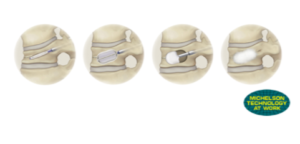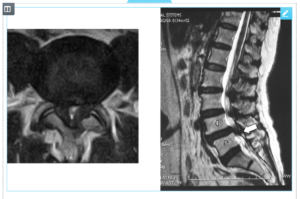Lumbar Spondylolysis and Spondylolisthesis
2022年5月10日
最終更新日時 :
2023年9月26日
 webmaster
webmaster
We will provide information on the surgical methods, length of hospital stay, insurance coverage, and more for spondylolysis and spondylolisthesis.
Lumbar Spondylolysis / Spondylolisthesis
What is Spondylolysis?
Spondylolysis is a condition where there is a discontinuity (separation) in the continuity of the bones that should normally be connected in the region known as the interarticular part of the vertebrae. It primarily occurs in the fifth lumbar vertebra (L5) and is commonly seen during the growth period in individuals who engage in sports activities. The cause is believed to be a stress fracture in the lumbar spine due to repetitive external forces applied to the lower back.
Symptoms
The primary symptom of this condition is lower back pain. However, because the pain is often only present during physical activity and may not be prominent in everyday life, it is not uncommon for it to be overlooked or left untreated."
Treatment methods
Early conservative treatments such as wearing a corset or cast can promote the healing of the fractured area. Early diagnosis requires not only X-rays but also additional tests such as CT scans or MRI. Therefore, it is essential to seek medical attention promptly if your child experiences lower back pain during physical activity. If a spondylolysis is left untreated, it can compromise the stability between adjacent vertebrae, resulting in a misalignment of bones known as spondylolisthesis. Severe slipping can lead to lower limb pain and numbness, sometimes necessitating surgery. Young individuals with incomplete bone growth are particularly susceptible to spondylolisthesis. Hence, early and accurate diagnosis and treatment are crucial.
Surgical Procedure 1:
Spondylolysis Repair Surgery
This surgical procedure involves grafting bone onto the separated portion when conservative treatments fail to promote healing, and symptoms such as severe back pain significantly impact academic and daily life.
Surgical Procedure 2:
Posterior Lumbar Interbody Fusion (TLIF)
This surgery is performed when spondylolisthesis progresses to the point of severe stenosis, resulting in significant nerve compression. (For more details on surgical procedures, please refer to the surgical treatment of spinal canal stenosis.)
Surgical Procedure 1:
Spondylolysis Repair Surgery
This surgical procedure involves grafting bone onto the separated portion when conservative treatments fail to promote healing, and symptoms such as severe back pain significantly impact academic and daily life.
Surgical Procedure 2:
Posterior Lumbar Interbody Fusion (TLIF)
This surgery is performed when spondylolisthesis progresses to the point of severe stenosis, resulting in significant nerve compression. (For more details on surgical procedures, please refer to the surgical treatment of spinal canal stenosis.)
- Body Area
- Lower Back and Buttocks
- Medical Condition
- Curvature of the Lower Back and Spine、Lower Back Pain and Buttock Pain

